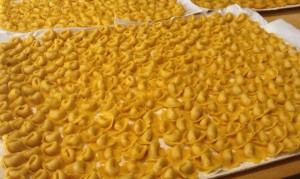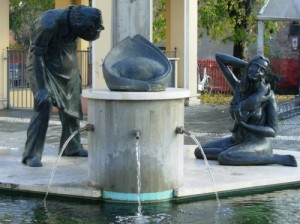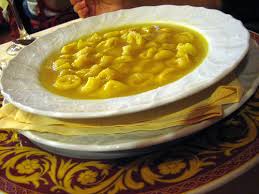Tortellini !!!Tortellini !!!
La storia
In passato, fra Bologna e Modena sono sorte infinite dispute sulla paternità del Tortellino. Dopo accese e dotte discussioni fu scelta la località di Castelfranco Emilia, luogo dell’immaginario incontro tra l’oste e il mitico ombelico.
La scelta non fu casuale, infatti Castelfranco è a metà strada tra Bologna e Modena, sino all’anno 1927 era in provincia di Bologna, ma dal 1927 passò in provincia di Modena, da qui nacque la vexata questio. Ora, pur essendo in provincia di Modena, fa parte della Diocesi di Bologna, questa diplomatica soluzione accontentò tutti. In ogni caso, bisogna sapere che la via Emilia è la via della pasta “ripiena” e poi “ritorta”, cioè una pasta ritorta su un ripieno, infatti Tortellino o Tortello derivano da “ritorto”.

Così partendo da Piacenza e passando per Parma incontriamo gli Anolini, a Reggio Emilia troviamo iTortelli alle erbe o alla zucca con amaretto e i Cappelletti di carne, scendendo a Modena, Castelfranco e Bologna gustiamo i Tortellini, proseguendo per Forlì abbiamo i Cappelletti di formaggio, facendo una piccola digressione a Ferrara mangiamo i Cappellacci di Zucca, ma senza amaretto.
Il Tortellino, come tutti i grandi, vanta numerose origini. Il poeta Alfredo Testoni scriveva polemicamente: “Non è vero che Bologna si sia fatta un nome perché “madre degli studi”. L’è pr’i turtlein e pr’al so’ consum ch’la s’è fatt una strada!” [è per i Tortellini e il loro consumo che si è fatta strada].
Per alcuni fu la nobildonna Dorotea Lapi, che si sarebbe ispirata ad un trattato del Trecento per soddisfare, almeno a tavola, i desideri del ghiotto marito. Altri invece sostengono che l’inventore sia stato Pietro Filargo divenuto poi Papa Alessandro V. Altre leggende si riferiscono all’ombelico muliebre: sul tema si esprime Ostilio Lucarini nella sua commedia “quell ch’ha inventà i turtlei” dove il cuoco Pirulein si sarebbe ispirato all’ombelico della sua padrona. Un’altra versione è data da Giuseppe Ceri, che in un suo poemetto burlesco, racconta come Venere, Marte e Vulcano capitarono nella locanda della Dogana, a Castelfranco Emilia, coricandosi tutti insieme in un grande letto. Al mattino seguente Vulcano e Marte scesero in cucina a rifocillarsi con un centinaio di uova. Il cuoco accorso ad una scampanellata di Venere, la trovò senza veli e nel contemplarla smarrì la ragione. Tornato in cucina tutto scombussolato volle immortalare quella visione. Non sapendo disegnare prese un poco di pasta e “l’oste che era guercio e bolognese per imitar di Venere il bellico l’arte di fare i tortellini apprese”.
Per immortalare questa leggenda, a Castelfranco Emilia, la Dotta Confraternita, assieme a quella di San Nicola di Castelfranco, inaugurò, in una piazza del paese, un monumento bronzeo.

Nel diario del Senato di Bologna nell’anno 1500 si riporta che a 16 tribuni della plebe fu servita una “minestra de torteleti”. Pochi anni dopo nel 1570 un cuoco bolognese, forse Bartolomeo di Scappi, cuoco del Papa Pio V, fece stampare alcune ricette dove venivano citati anche i Tortellini.
Come si può capire le storie sono tutte graziose e intriganti, in realtà un vero inventore del tortellino non esiste o almeno non se ne ha notizia certa. Il vero punto fermo sul Tortellino lo pose Pellegrino Artusi che, alla fine dell’ottocento, codificò il classico ripieno ufficializzando la mortadella, contribuendo con la sua opera a diffonderne la fama.
Ingredienti per circa 1000 tortellini:
pasta fresca gialla preparata con 3 uova e 3 etti di farina
Per il ripieno:
300 gr. lombo di maiale rosolato al burro
300 gr. prosciutto crudo
300 gr. vera mortadella di Bologna
450 gr. formaggio Parmigiano Reggiano
3 uova di gallina
odore di noce moscata
Per il brodo:
1 kg. di carne di manzo (doppione)
½ gallina ruspante
sedano
carota
cipolla
sale

La preparazione
Deve essere molto accurata. Il lombo va tenuto in riposo per 2 giorni con sopra un battuto composto di sale, pepe , rosmarino ed aglio, quindi va cotto a fuoco lento con un po’ di burro e poi va tolto dal tegame e ripulito del suo battuto. Infine, possibilmente col battilardo, si trita molto finemente il lombo, il prosciutto e la mortadella, si impasta il tutto con parmigiano e uova, aggiungendo l’odore della noce moscata. L’impasto si deve mescolare a lungo fintanto che risulti ben amalgamato e deve essere lasciato riposare per 24 ore, prima di riempire i tortellini.
Naturalmente la bontà del ripieno dipende dalla qualità delle materie prime impiegate. Per gustare un buon tortellino è indispensabile disporre di un ottimo brodo.
Fonte: Confraternita del tortellinoHistory
In the past there were a lot of controversies between Bologna and Modena about the paternity of tortellino. After a number of heated discussions they chose the village of Castelfranco Emilia, which was the place of the imaginary meeting between the innkeeper and the “mythical navel“.
The choice was not fortuitous. In fact Castelfranco is half way between Bologna and Modena. It was in the province of Bologna until 1927 when it was in the Estense dukedom but since 1927 it has been in the province of Modena. That is why the vexed question was born. Now, even if it is in the province of Modena, it is part of the diocese of Bologna. This is the diplomatic solution which succeeded in meeting everybody’s wishes. Anyway everybody must know that the “Via Emilia” (Emilia street) is known as the street of the “twisted” pasta, that is a twisted pasta with a filling inside. In fact tortellino or tortello means “twisted”.

So, leaving Piacenza and going through Parma, we meet the Anolini, in Reggio Emilia there are the Tortelli with vegetables (in the filling there are green vegetables, such as herbs, and ricotta) or Tortelli with squash and amaretto and Cappelletti with meat. Coming down through Modena, Castelfranco and Bologna we can tasteTortellini. Continuing along the via Emilia, we reach Forlì where we find Cappelletti with cheese and if we go to Ferrara we can eat the Cappellacci with squash but without amaretto.
The tortellino, like all the big symbols, boasts of numerous origins. The poet Alfredo Testoni wrote about this matter in a controversial tone: “Bologna is not famous because it is “mother of learning”. L’è pr I turtlei e pr’l so consum ch’la s’è fatt una strada!” [It is only thanks to the tortellini and their success everywhere that Bologna is so well known]
According to one of the theories it was the noblelady Dorotea Lepi who, after reading a XIV century treatise, decided to meet her greedy husband’s needs at least when dinner was served! Another theory is that the inventor was Pietro Filargo who became Pope Alexander V. A number of legends refer to the feminine navel: Ostilio Lucarini, for exemple, in his comedy: “Quell ch’ha inventà i turtlei” [The person who invented tortellini] tells the story of the cook Pirulein who was inspired by his landlady’s navel. Giuseppe Ceri, in his burlesque poem, tells that Venus, Mars and Volcano met one evening at the Dogana’s Inn in Castelfranco Emilia (a village in the suburbs of Bologna) and they spent the night there sleeping together in the same bed. The following morning Volcano and Mars went down to the kitchen to take refreshment with 100 eggs. In the meantime the cook went to the room to serve Venus and he realized she was naked. He gazed at her and went mad! He went back into the kitchen and was very confused but he decided to immortalize that vision. As he was not able to draw he took a piece of dough and “l’oste che era guercio e Bolognese per imitar di Venire il bellico l’arte di fare I tortellini apprise” [The innkeeper, who was cross-eyed and Bolognese, in order to remember the navel of Venus, created the art of making tortellini].
In order to immortalize this last legend the “Learned Brotherhood”, together with the “Saint Nicholas’ Brotherhood” in Castelfranco, unveiled a bronze statue in one of the Squares of the village.

In the year 1500 in the diary of the Senate in Bologna there is written that a “minestra de torteleti” [soup of tortellini] was served to 16 of the tribunes. A few years later, in 1570, a Bolognese cook, possibly Bartolomeo di Scappi, who was Pope Pio V’s cook, published some recipes where tortellini were mentioned.
All the theories are amusing and intriguing but, as a matter of facts, a real inventor of the tortellino doesn’t exist or at least we don’t know for sure. The only certainty was given by Pellegrino Artusi who, at the end of the XIX Century, codified the classic filling which included mortadella. He contributed, with his work, to propagate its fame.
For about 1000 tortellini:
300 gr. pork loin
300 gr. prosciutto
300 gr. genuine mortadella from Bologna
450 gr. parmesan cheese
3 chicken eggs
nutmeg flavour
For the broth:
1 kg. of beef
½ farmyard cappone [hen]
.celery
carrot
onion
salt

The preparation
It must be very thorough: you must put a mixture of salt, pepper, rosmary and garlic on the loin and leave it in a pan for two days, then cook it on a slow frame adding a little butter. Take it out of the fire and clean it from the mixture. Then mince the pork, the prosciutto and mortadella very finely and knead everything with parmesan cheese and the eggs. Add the flavour of the nutmeg. The dough must be mixed for a long time until it is well amalgamated and it must rest for at least 24 hours before filling the tortellini.
Of course the excellence of the filling depends on the quality of the raw materials. In order to taste a good tortellino you must prepare an excellent broth which you can make putting a farmyard capon into the water and adding those parts of the beef that are notoriously suitable for broth, such as the brisket etc.
source: Confraternita del tortellino





Leave a comment